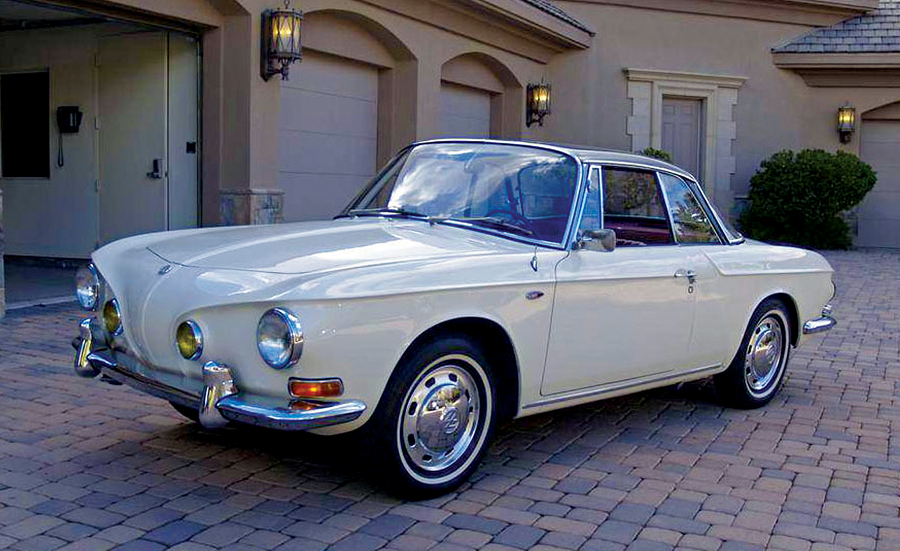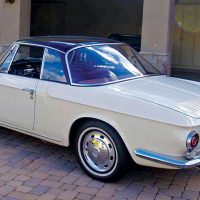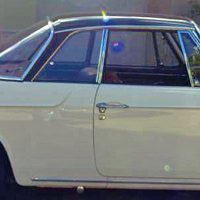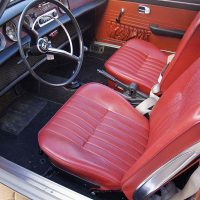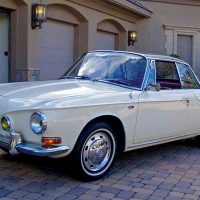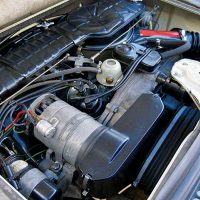- Rare Type 34, never sold in U.S.
- Recently serviced
- Numbers-matching
- De Luxe package
SCM Analysis
Detailing
| Vehicle: | 1968 Volkswagen Karmann Ghia Type 34 |
| Years Produced: | 1961–69 |
| Number Produced: | 42,498 |
| Original List Price: | $2,850 |
| SCM Valuation: | $31,625 |
| Tune Up Cost: | $60 |
| Chassis Number Location: | Beneath rear seat, center tunnel |
| Engine Number Location: | Engine case, center |
| Club Info: | Type 34 Karmann Ghia Registry |
| Website: | http://www.type34.com/forum/index |
| Alternatives: | 1956–74 VW Karmann Ghia Type 14, 1962 Alfa Romeo Giulia, 1960–69 Chevrolet Corvair |
| Investment Grade: | C |
This car, Lot 801, sold for $39,600, including buyer’s premium, at Barrett-Jackson’s Las Vegas Auction on October 5, 2019.
The pretty Beetle
“For nearly $1,000 more [than a VW Beetle], the customer is acquiring a very pretty body.” When Road and Track wrote that after driving the new Volkswagen Karmann Ghia in 1956, they meant it as a bit of a dig.
The implication was that while the Karmann Ghia’s styling was lovely, its Beetle-based underpinnings and 1,200-cc flat 4 meant that it could never be more than a Bug in a dress. Well, it was a stunning dress, and VW made almost 500,000 Type 14 Karmann Ghias with very few cosmetic changes between 1956 and 1974.
These cars are just now starting to get attention as affordable alternatives to more well-known sports cars. What casual Ghia buyers might not realize is that the curvy-hipped Karmann Ghia that Road and Track found lacking is not the only pretty body to wear that name.
The razor-edge Ghia
Volkswagen planned to replace the Type 14 with a bigger, faster sporty coupe, and it introduced the Type 34 Ghia in 1961. While the earlier Karmann Ghia was based off the VW Bug, the Type 34 was longer and wider, based on the Type 3 Volkswagen.
The new model’s design still came from the Italian design studio Ghia, but with sharp, crisp lines where the Type 14 was softly rounded, earning the Type 34 the nickname, “Razor Edge.”
Only 42,000 Type 34 Karmann Ghias were made between 1961 and 1969. The Type 34 was Volkswagen’s most well-appointed offering, with front disc brakes, a bigger engine and a higher top speed, but it never caught on the way VW hoped.
Eventually the car was retired to clear up production-line space for new Porsche models, and Karmann Ghia collectors believe fewer than 3,000 Type 34s still exist today. The Type 34 was not available to dealers in the United States, but a few hundred found their way stateside from Canada, so you do occasionally see them pop up at VW meets and auctions.
All this brings us to our subject car, a white-and-red Type 34.
De Luxe-ury
By 1968, Volkswagen was almost done with the Type 34 Karmann Ghia, although it would continue making the Type 14 until the mid-1970s. Some of the things that set the Type 34 apart, such as the 1,600-cc engine, available semi-automatic, and superior suspension, had made their way to the Type 14 by the late 1960s, but the Type 34 remained roomier and more exotic.
A car like this one is bound to turn heads and start conversations.
It’s already an eye-catching shape and color combo, and the De Luxe trim adds on goodies such as a heated rear window, hazard lights and reverse lights.
When you pull into a car show in a Type 34, most folks won’t know what it is, but they’ll want to.
One glance at that wood-grain dash, 100-mph speedometer and strawberry-red interior and they’re going to start guessing.
“Corvair? Alfa? Something Italian, it must be,” and you can tell them that they are partially right. This car has an Italian outfit over good ol’ reliable Volkswagen 4-cylinder and 4-speed manual.
Good buy?
Because there are so few Type 34 Karmann Ghias available, it’s hard to find equivalent cars to compare prices.
This car is mostly original and numbers-matching, which in itself is rare, as it is not uncommon for Type 34 Ghias to get a replacement Type 3 chassis when rust took its inevitable toll.
With fewer than 70,000 miles and a well-documented maintenance record, this little Ghia looks ready to drive across America, spreading the gospel of the Razor’s Edge. Considering its Emden radio, comfortable seats, disc brakes, and 4-cylinder fuel mileage, if the new owner does just that, we’d call this car well bought. ♦
(Introductory description courtesy of Barrett-Jackson.)
